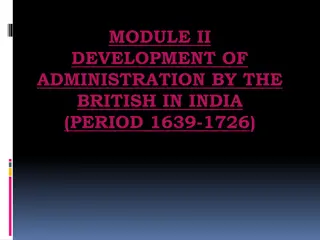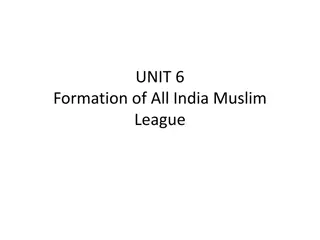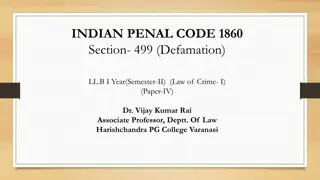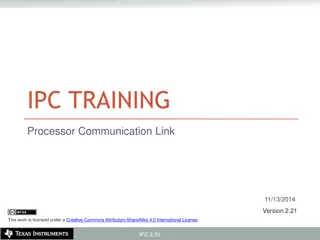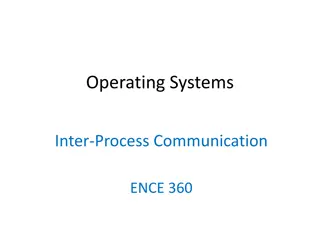Development of Indian Penal Code (IPC) 1860 and Its Impact in British India
The Indian Penal Code (IPC) of 1860 was introduced in British India after a series of historical events led to the need for a comprehensive criminal justice system. The disintegration of the Mughal Empire paved the way for British takeover, resulting in variations in criminal laws across different British territories. The IPC, with its 549 sections, aimed to streamline the administration of justice. It defined offenses and corresponding punishments, emphasizing the importance of mens rea and actus reus. The IPC played a crucial role in shaping the criminal justice system in India.
Download Presentation

Please find below an Image/Link to download the presentation.
The content on the website is provided AS IS for your information and personal use only. It may not be sold, licensed, or shared on other websites without obtaining consent from the author.If you encounter any issues during the download, it is possible that the publisher has removed the file from their server.
You are allowed to download the files provided on this website for personal or commercial use, subject to the condition that they are used lawfully. All files are the property of their respective owners.
The content on the website is provided AS IS for your information and personal use only. It may not be sold, licensed, or shared on other websites without obtaining consent from the author.
E N D
Presentation Transcript
INDIAN PENAL CODE, 1860 (Till General Exceptions) MR. PRANAV VERMA
British India - Mughal administration of the criminal justice system - Disintegration of the Mughal Empire rise of regional leaders justice by geography? - British takeover of territories English criminal law, such as in Presidency towns - But variations even within British territories - Different Presidencies passed different Regulations - E.g. in the Bengal Presidency, serious forgeries were punishable with imprisonment for a term double the term fixed for perjury; whereas in the Bombay Presidency, perjury was punishable with imprisonment for a term double the term fixed for the most aggravated forgeries. Likewise in the Madras Presidency, the two offences were exactly on the same footing. - No coherent and uniform system of administering criminal justice
- To streamline the CJS in British India, the Governor-General of India in Council by virtue of the authority vested in him under Section 53 of the GoI Act 1833 appointed the Indian Law Commissioners in 1834 to inquire into the then existing state of criminal law and suggest a comprehensive penal code for India. - Thus in 1834 the First Law Commission of India was constituted Lord Macaulay as the President, with Macleod, Anderson, and Millet as commissioners - But it was only on 6 October 1860 that the IPC came into force.
- - - - - Defines offences ingredients to be satisfied Followed by punishments An almost scientific determination? Total 549 sections Colonial continuities? 377 (only recently read down;); sedition; death penalty General law v special law Concurrent list of the Constitution IPC is the substantive law; CrPC is the procedural law Mens rea + actus reus (but also, strict liability) Adversarial v Inquisitorial system Against society, not just person Actus non facit reum nisi mens sit rea there can be no crime without a guilty mind Importance of trial courts gatekeepers of constitutional guarantees?S - - - - - - - -
Section 1: extends to the whole of India Section 2: Punishment of offences committed within India - Every person (implication?) - every act or omission contrary to the provisions of the code - of which he shall be guilty within India Intra-territorial operation of the code The territory of the state also includes its ships, aircrafts etc. every person a foreigner who initiates an offence outside India that takes effect on the Indian territory is liable under the penal code for such offence. What matters is that the act in question was an offence in India. Even the actual physical presence of the accused in India is not necessary, and all that matters is that the ingredients of the offence occurred in India. Mobarik Ali v State of Bombay (AIR 1957 SC 857): A Pakistani citizen while staying at Karachi, made false representations to the complainant in Bombay through letters, telephone calls etc.; and induced him to pa 5 lakh rupees to the agents of the accused at Bombay in return for shipping of rice from Karachi to India. The rice was never supplied. The SC upheld the conviction of the accused holding that the offence was committed at Bombay even though the accused was not physically present there.
Section 3: Punishment of offences committed beyond, but which by law may be tried within, India. - Any person - Liable by any Indian law - Offence committed beyond India - Dealt with under this Code in the same manner if such act had been committed within India Extraterritorial operation of the Code What matters is that the person to be tried is subject to the Indian law E.g. if a soldier of the Indian Army commits murder in Nepal while in service, he is liable to be prosecuted for murder in India.
Section 4: Extension of Code to extra-territorial offences The provisions of this Code apply to any offence committed by: 1. Any citizen of India in any place without and beyond India 2. Any person on any ship or aircraft registered in India wherever it may be 3. Any person in any place without and beyond India committing offence targeting a computer resource located in India Explanation (a) offence includes every act committed outside India which if committed in India would be punishable under the IPC Section 4 also deals with extra-territorial application of the IPC
More on Section 3 IPC - liable, by any Indian law means subject to any Indian law (by virtue of being a citizen) - While this is to be inferred from Section 3, it is very directly incorporated in Section 4. Both Section 3 and Section 4 deal with extra-territorial application of the IPC and Section 4 extends the principle embodies in Section 3. - See the Illustration attached to Section 4: A, who is a citizen of India, commits a murder in Uganda. He can be tried and convicted of murder in any place in India in which he may be found . - This is further clarified in Section 188(a) of the Code of Criminal Procedure, 1973: 188. Offence committed outside India. When an offence is committed outside India- (a) by a citizen of India, whether on the high seas or elsewhere; or (b) by a person, not being such citizen, on any ship or aircraft registered in India, he may be dealt with in respect of such offence as if it had been committed at any place within India at which he may be found: Provided that, notwithstanding anything in any of the preceding sections of this Chapter, no such offence shall be inquired into or tried in India except with the previous sanction of the Central Government. Courts have applied Sections 3 and 4, IPC, and Section 188 CrPC together: Remla v SP of Police, (1993) 1 KLT 412; Md. Shameer Ali v State of Kerala, (2019) 3 KLT 1034
Section 34: Acts done by several persons in furtherance of common intention - criminal act - done by several persons - in furtherance of common intention of all - each of such persons is liable for that act in the same manner as if it were done by him alone Section 34 JOINT LIABILITY (I) Object? At times difficult to distinguish between criminal acts of individual members in a joint enterprise where multiple persons are involved or to prove what exact part was taken by them. Not a substantive offence, but only a rule of evidence. Based on the case of Reg v Cruse, 1838 C&P 541: A police constable went to A s house to arrest him. On seeing the constable, B, C, and D came out of the house; gave the constable a blow; and drove him off. The court evolved the doctrine of joint liability and held that each of the members of the group B, C and D were equally responsible for the blow, whether one actually struck it or not.
The individual acts of group members may be different, but all must in one way or the other participate in the criminal enterprise. For e.g., one may only stand as a guard to prevent a person from coming to the relief of the victim, while his accomplice deals a blow to the victim s head. He does so in furtherance of the common intention of both of them to hit the victim, and hence is to be punished in the same manner as the person who actually deals the blow. Section 34 JOINT LIABILITY (II) It is necessary that for section 34 to apply against someone, they must be physically present at the actual scene of the crime in order to facilitate the commission of the offence. The essence of section 34 is that there is present a simultaneous consensus in the mind of all present to commit the offence, even if they contribute in their own individual ways and capacities towards such commission. Pandurang Tukia and Bhillia v State of Hyderabad, AIR 1955 SC 331: the word common intention implies a prior concert/prior meeting of the minds + participation of all members of the group in the execution of that plan
A, B, and C proceed to Ds house in order to avenge an insult by the brother of D. They open fire upon the members of D s family. It was found that the shots of A did not hit anyone, but the shots of B and C succeeded in killing D. Section 34 JOINT LIABILITY (III) Since the act of firing was done with the common intention of the group to take revenge, A is as much liable for the offence of murder as much B and C.
Barendra Kumar Ghosh v King Emperor, AIR 1925 PC 1: The Appellant was charged and convicted under Section 302 read with Section 34, IPC with the murder of a Sub-Postmaster. The Appellant s contention was that he was the man outside the room, and not the man who fired the fatal shot, and hence not liable for murder. This contention was rejected by the court. Section 34 JOINT LIABILITY (IV) Section 34 deals with the doing of separate acts, similar or diverse, by several persons; if all are done in furtherance of a common intention, each person is liable for the result of them all, as if he had done them himself
Mahboob Shah v Emperor, AIR 1943 PC 118 Facts: Allah Dad (deceased) and a few other were going to the Indus river to cut and collect reeds. On their way, they saw Mohammad Shah, the father of Wali Shah (absconded). MS warned them against collecting the reeds as the land belonged to him, but AD still collected the reeds. While placing them in his boat, he was accosted by Qasim Shah, the nephew of MS, who tried to remove the reeds from the boat. He then pushed AD who picked up the bamboo pole (10 ft long and 6 inches thick) used to row the boat and struck QS with it. QS shouted for help. WS and MS appeared on the scene with loaded guns. On seeing them AD and his friend tried to run away, but WS fired at AD who died almost instantly. MS fired at the friend of AD causing him slight injuries. Section 34 JOINT LIABILITY (V) Will Section 34 apply?
Mahboob Shah v Emperor, AIR 1943 PC 118 (contd) Both WS and MS were convicted for murder under Section 302 r/w Section 34, IPC. MS went in appeal and his appeal was allowed. MS murder conviction was set aside as there was no evidence and no circumstances from which it could be inferred that he acted in concert with WS in furtherance of a pre-arranged plan, when he rushed with him to the rescue of QS. Section 34 JOINT LIABILITY (VI) If anything, the intention developed on the spot and there was no pre- arranged plan to commit murder. Held, common intention within the meaning of the section implies a pre-arranged plan, and to convict the accused of an offence applying the section, it should be proved that the criminal act was done in concert pursuant to the pre-arranged plan
Jasdeep Singh @ Jassu v State of Punjab Crl App No. 1584 of 2021 Decided on: January 7, 2022 Holdings: 1. A mere common intention per se may not attract Section 34 IPC, sans an action in furtherance. There may also be cases where a person despite being an active participant in forming a common intention to commit a crime, may withdraw from it later 2. The phrase in furtherance of the common intention of all was added to the statute book through an amendment to clarify the scope of Section 34. It was first coined by Chief Justice Barnes Peacock presiding over a bench of the Calcutta High Court in Queen v Gorachand Gope (1866) which would have probably inspired and hastened the amendment to Section 34 IPC 3. The onus to prove common intention is on the prosecution. The quality of evidence will have to be substantial, concrete, definite, and clear. Section 34 JOINT LIABILITY (VII)
Jasdeep Singh @ Jassu v State of Punjab Crl App No. 1584 of 2021 Decided on: January 7, 2022 Holdings (CONTD.): Section 34 JOINT LIABILITY (VIII) 4. It is a team effort akin to a game of football involving several positions manned by many, such as defender, mid-fielder, striker, and a keeper. A striker may hit the target, while a keeper may stop an attack. The consequence of the match, either a win or a loss, is borne by all the players, though they may have their distinct roles. A goal scored or saved may be the final act, but the result is what matters. As against the specific individuals who had impacted more, the result is shared between the players. The same logic is the foundation of Section 34 IPC which creates shared liability on those who shared the common intention to commit the crime.
Jasdeep Singh @ Jassu v State of Punjab Crl App No. 1584 of 2021 Decided on: January 7, 2022 Holdings (CONTD.): Section 34 JOINT LIABILITY (IX) 5. The intendment of Section 34 IPC is to remove the difficulties in distinguishing the acts of individual members of a party, acting in furtherance of a common intention. There has to be a simultaneous conscious mind of the persons participating in the criminal action of bringing about a particular result. A common intention qua its existence is a question of fact and also requires an act "in furtherance of the said intention".
Kripal Singh v State of Uttar Pradesh, AIR 1954 SC 706 Long-standing dispute over land between the accused and the deceased X. One morning the accused saw two labourers going to X s land to work there. The accused shouted at them to not do so, but in vain. Thereafter the accused rushed towards them and began attacking them with spears. Meanwhile X also arrived to stop the attack, but the accused then attacked him. Section 34 JOINT LIABILITY (X) B and C attacked on his legs, and he fell. Then A stabbed X on his head with the spear. The spear blade got stuck in X s jaw, and hence A put his leg on X s chest to extract the blade out. The blow had gone through the skull and injured the brain, and X died on the spot. Decide the liability of A, B, and C.
Kripal Singh v State of Uttar Pradesh, AIR 1954 SC 706 (CONTD) A: blow given with the deliberate intention to kill on the head of a fallen and helpless man lying on the ground with such force so as to penetrate the skull. Liable under Section 302 IPC (Punishment for murder). B and C: no common intention between A, B, and C to kill X. The only common intention attributable to B and C was to beat him with weapons causing grievous injuries. Not liable under Section 302 r/w Section 34, IPC. Rather, even though the injuries caused by them were simple, they were held guilty under Section 326 (Voluntarily causing grievous hurt by dangerous weapons or means) r/w Section 34, IPC, because of the common intention of all to attack X with sharp cutting weapons Section 34 JOINT LIABILITY (XI) Two points here: 1. B and C s common intention was not to kill 2. Their injuries caused were simple, but still liable for grievous injuries because A s actions lead to grievous injuries + death. Because causing grievous injuries was part of the common intention of all A, B and C, B and C will also be liable for grievous injuries caused by A. Though for death, only A liable.
Kripal Singh v State of Uttar Pradesh, AIR 1954 SC 706 (CONTD) Also held: a preconcert in the sense of a distinct previous plan is not necessary to be proved. The common intention to bring about a particular result may well develop on the spot as between a number of persons, with reference to the facts of the case and circumstances of the situation. Whether in a proved situation all the individuals concerned therein have developed only simultaneous and independent intentions or whether a simultaneous consensus of their minds to bring about a particular result can be said to have been developed and thereby intended by all of them, is a question that has to be determined on the facts. Section 34 JOINT LIABILITY (XII)
Rishi Deo Pandey v State of Uttar Pradesh, AIR 1955 SC 331 Two accused A and B were brothers, were seen standing near the cot of the victim who was sleeping. A was armed with a gandasa and B, with a lathi were seen running together out of the deceased s bedroom when a hue and cry was raised. The medical evidence showed that the deceased dies of an incised wound on the neck, which was necessarily fatal. Held, liable under Section 302 r/w Section 34, IPC. Section 34 JOINT LIABILITY (XIII) It is now well settled that the common intention referred to in Section 34 presupposes a prior concert, a pre-arranged plan, i.e. a prior meeting of minds. This does not mean that there must be a long interval of time between the formation of the common intention and the doing of the act. It is not necessary to adduce direct evidence of the common intention. Indeed, in many cases it may be impossible to do so. The common intention may be inferred from the surrounding circumstances and the conduct of the parties.
Wasim Khan v State of Uttar Pradesh, AIR 1956 SC 400 What happens if out of the multiple accused persons, all but one are acquitted? Can one person be convicted by reason of application of Section 34? Section 34 JOINT LIABILITY (XIV) Held, a single accused could also be convicted by applying Section 34, if it were established beyond doubt that such an accused shared the common intention to commit the offence with some person other than the one who was acquitted. In the facts of this case, it was established that he had committed the offence jointly with two other unidentified persons. There was no illegality in such a conviction.
Bharwad Mepa Dana v State of Bombay, AIR 1960 SC 289 Some of the accused charged at a joint trial under Section 34 were acquitted. The SC held that the test for determining whether the remaining accused one or more could be convicted under Section 34 is this Did the remaining accused share a common intention to commit a crime only? Did they participate in the commission of a crime? If on the evidence on record such intention + participation are established, there is nothing illegal in their conviction by applying Section 34, IPC. Section 34 JOINT LIABILITY (XV)
Same or similar intention v/s common intention Care should be taken to not confuse same or similar intention, with common intention of all. Multiple people can have the same or similar intention at the time of the commission of an offence. However, if each of them is not aware of the other s intention, it is not common intention of all . Hence, what matters is that the intention of each person be known to all others and be shared by them for it to constitute common intention of all . Mere similar or same intention in the absence of awareness and agreement about each other s intention is not enough. There is no prior meeting of minds in same or similar intention. Section 34 JOINT LIABILITY (XVI) Gaya Prasad Ramlal v State of Maharashtra, AIR 1971 SC 1112 : 1971 CrLJ 824: It is an indisputable statement of law that common intention requires a prior meeting of minds, and is not to be equated with mere similar or same intention.





